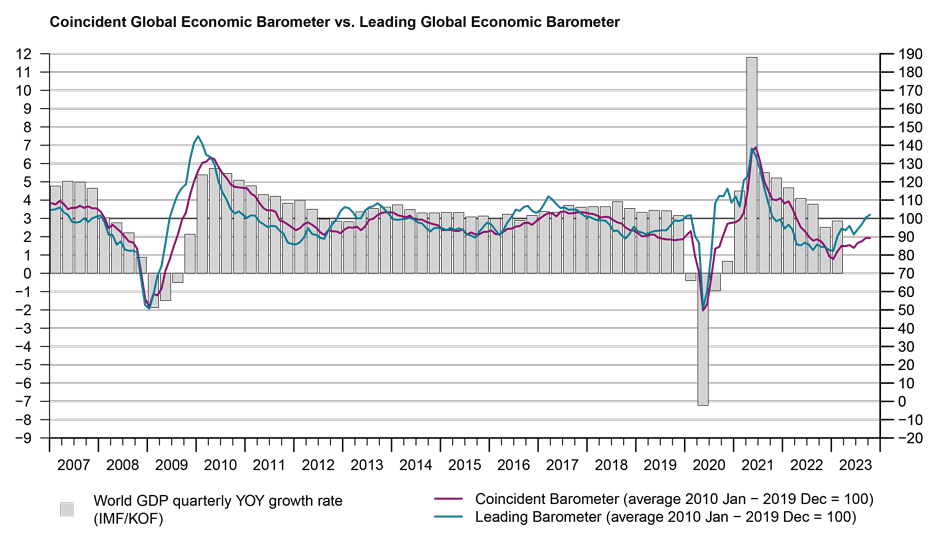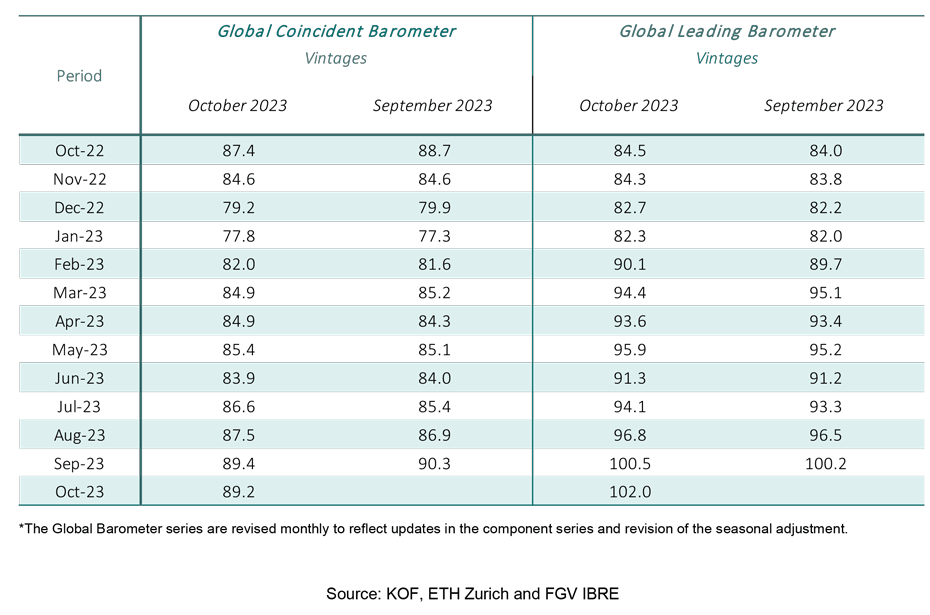Leading Global Barometer climbs above the 100-point average
The Leading Global Barometer rises for the fourth month in a row, moving more clearly into the over 100 points range, suggesting an above average acceleration in world economic growth over the next three to six months. The slight decline in the Coincident Barometer shows that this framework is likely to be reached gradually.
The Coincident Global Economic Barometer falls 0.2 points in October to 89.2 points, while the Leading Barometer moves in the opposite direction and increases 1.5 points to 102.0 points, the highest level since September 2021 (108.5 pts.). In both cases, the results were mainly driven by the Asia, Pacific & Africa region. With this month’s results, the difference between the two Global Barometers is 12.8 points, the largest since April 2022 (14,1 points).
“Although the assessment of the current situation has not improved, the outlook has continued its upward trend. The widening gap between the leading and coincident indicators usually indicates that it is only a matter of months before the actual assessment of business and consumer sentiment around the world also improves. Nevertheless, we are still a long way from anything that could be called a boom. Political tensions and the resulting subdued opportunities for at least the majority of companies, together with high interest rates, do not create an investment-friendly environment. So the best we can hope for is a broad normalisation”, evaluates Jan-Egbert Sturm, Director of KOF Swiss Economic Institute.

“We are still a long way from anything that could be called a boom. The best we can hope for is a broad normalisation.”Jan-Egbert Sturm, Director of KOF Swiss Economic Institute
Coincident Barometer – regions and sectors
The slight drop in the Coincident indicator was driven by the negative contribution of the Asia, Pacific & Africa region, of -0.8 points, which was partly compensated by the positive contributions of Europe and the Western Hemisphere, with 0.5 and 0.1 points, respectively. This month, the Coincident indicator for the Western Hemisphere has the highest level among the regions, which last occurred in July 2021. This result may have been influenced by the resilience in economic activity in countries like Brazil and the United States. The graph below illustrates the contribution of each region to the deviation of the Coincident Barometer from the historical mean of 100 points.
The Coincident sector indicators evolve heterogeneously in October, with Services and Construction falling, Trade rising, and Industry and Economy (aggregated business and consumer evaluations) remaining stable.
Leading Barometer – regions and sectors
The Leading Global Barometer leads the world economic growth rate cycle by three to six months on average. In October, the positive regional contributions come from the Asia, Pacific & Africa region and Europe, both with 1.0 point, while the Western Hemisphere makes a negative contribution of -0.5 points. The level of the overall indicator suggests a more widespread perception of an acceleration in the growth rate over the coming months. While the bundle of indicators for the Asia, Pacific, Africa region is above average, it is below average for the Western Hemisphere. The one for Europe is on average.
In October, all the Leading sector indicators increase and reach levels above 100 points, with the exception of the Construction sector, where the indicator remains at an adverse level, below 90 points.
The Global Economic Barometers
The Global Economic Barometers are a system of indicators enabling timely analysis of global economic development. They represent a collaboration between the KOF Swiss Economic Institute of the ETH Zurich in Switzerland and Fundação Getulio Vargas (FGV), based in Rio de Janeiro, Brazil. The system consists of two composite indicators, the Coincident Barometer and the Leading Barometer. The Coincident Barometer reflects the current state of economic activity, while the Leading Barometer provides a cyclical signal roughly six months ahead of current economic developments.
The two Barometers comprise the results of economic tendency surveys conducted in more than 50 countries with the aim of achieving the broadest possible global coverage. The advantages of economic tendency surveys are that their results are usually readily available and are not substantially revised after first publication.
The Coincident Barometer includes more than 1,000 different time series, while the Leading Barometer consists of over 600 time series. Cross-correlation analysis is used to decide which individual time series are included in the barometers. This involves correlating the individual time series with a reference series. The reference series used is the year-on-year growth rate of global gross domestic product (GDP), where the individual national GDPs are aggregated at purchasing power parity to form global GDP. A time series is only included in a Barometer if it shows a sufficiently high correlation and a suitable synchronization or lead with the reference series. The time period used for this correlation analysis currently runs from January 2010 to December 2019.
The series of the two Barometers are revised each month at publication and are standardized to have a mean of 100 and a standard deviation of 10 for the 10-year period previous to the most recent observations.
The methodology is described in:
Klaus Abberger, Michael Graff, Aloisio Jr. Campelo, Anna Carolina Lemos Gouveia, Oliver Müller and Jan-Egbert Sturm (2020), The Global Economic Barometers: Composite indicators for the world economy. KOF Working Papers, vol. 471, Zurich: KOF Swiss Economic Institute, ETH Zurich, 2020.
Contact
KOF Konjunkturforschungsstelle
Leonhardstrasse 21
8092
Zürich
Switzerland


